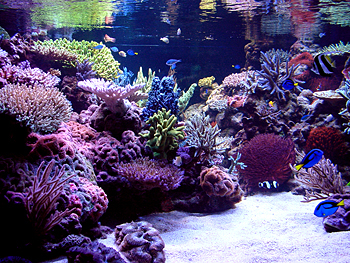Aquascaping is perhaps the single most difficult thing to accomplish….. at least for me. I wanted to achieve a sense of realism with this system; and, I felt that a more cube-like display tank would be the answer. With the extreme depth component ( 90 inches from front to back) coupled with the width of 72 inches, I felt that the construction of a realistic slice of the ocean is in my grasp.
Since it is a requirement of mine to completely hide all man-made objects like plumbing pipes and overflows, the aquascaping configuration had to be determined before the tank was even built. I decided upon a central canyon concept with a sandy trench extending from the front to back. With this in mind, I was able to contract the tank’s construction.
The center canyon concept meant that the rear acrylic panel must be kept constantly clean to preserve the illusion of infinite horizontal depth. The concept also meant that the sides of the display tank would need to be made from solid, black acrylic since these side panels would have rocks piled against them. The black acrylic side panels would also eliminate the reflections that clear acrylic has on side panels.
With the concept of a central canyon in place, I then began the rock structure. I tried to create an aquascape with as many ledges, drop-offs, and channels as possible to avoid the “pile of rocks look”. I also had to make sure that the rocks were no closer than 8 inches from the rear or front panels to facilitate the cleanings of these panels. All plumbing pipes, overflows, and rock supporting structures also had to be completely hidden…. and finally, the lighting was directed away from the display tank’s sides to shade these unsightly areas and draw the viewer’s eye back towards the center.
 All the rocks are sitting either on the acrylic bottom or on the rock supporting structures. Some rocks are adhered together with epoxy to create ledges, pillars, and over-hangs. The corals themselves are placed to please the eye... meaning that coral colors are taken into consideration when their location is being determined. The shape of corals is also taken into consideration...small specimens with particular interest are placed up by the front panel where their details can be easily enjoyed while larger specimens are placed towards the rear to act as a sort of background.
Aquascaping is a dynamic process that never really ends. As corals grow, so changes the aquascaping. As new specimens arrive, sometimes an older specimen might have to be removed. But, it is these changes that make this dynamic artwork so appealing.
Top |

